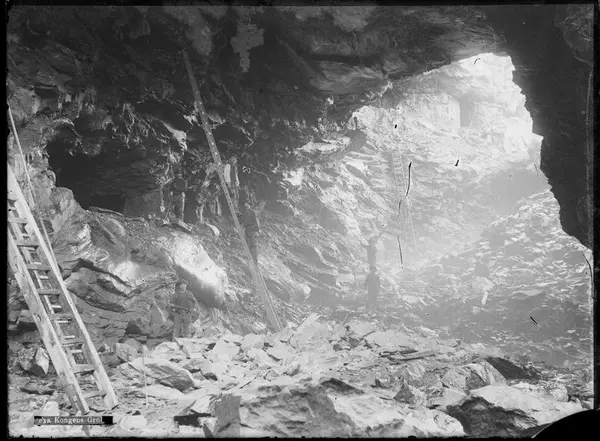-
Miners caught where the light penetrates the mine. Ca. 1900 E. Olsen
Randi Borgos and Amund Spangen
Christianus Sextus was discovered in 1723 and in 1735 another discovery was made on the mountaiside above closed mine at Arvedalsgruva. This new discovery was given the name of the King’s mine. There were many periods at Nordgruva when
the results were bad, and the whole field was closed on several occasions. Things improved in 1849 when the two mines, Arvedal and Kongens mine were run together. It became much easier to pump out water and transport the ore out of the mines and this helped to produce better results at Kongens gruva for several years. However, the really good times started at the end of the 1870s. The Røros railway line was opened in 1877 and introduced a revolution in transportation. It was then possible to start working on the pyrites deposits, and, for example, in 1889 some 32,000 tons of pyrites ore was taken out compared to only 4,800 tons of copper ore.
During this time there were many discoveries of copper ore made and at the same time radical changes were taking place through the modernisation of production techniques. In 1886 a narrow gauge railway was built by the Company to join Kongens gruva to the Røros railway line at Tyvoll in Rugedalen. The Arvedal line gave way to a cable lift built in 1910. These were the years that electricity was introduced to Kongens. In 1892 the labour force amounted to almost 350 men who lived there together with their families. They had their own post office, and there were some shops, and, for a time, there was a school. As the 1990s progressed, results again started to deteriorate. The economically difficult years between the great Wars also set their stamp up in the mines. From 1920 onwards work was only sporadic. And by 1940 the Christianus Sextus mine closed down, and five years later, Kongens
closed.
From 1946 everything was quiet at the Nordgruve field. All mining and other activity was stopped. It was no longer possible for people to live there. The last person to move away from Kongens was Kornelius Schanke (1883-1961). He continued to live there for several years after the mine was closed. He had been employed as caretaker and jack-of-all-trades. The photographs, which are reproduced here, were found in an album belonging to Signe Sorken (1912-1987) she was Kornelius Schanke’s daughter. Signe had nine brothers and sisters and all of them were born and grew up at Kongens. These children, together with their playmates, were the last children who, in all sorts of weather walked the 8 kms. in each direction, to get to the school at Nyplassen.
Literature
The entire article is taken from the book: ‘På Sta’a og uti markom’ Bind I, Randi Borgos and Amund Spangen 2001.
